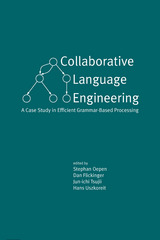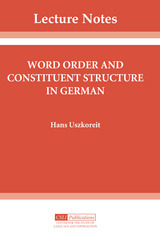2 books by Uszkoreit, Hans

Collaborative Language Engineering
A Case Study in Efficient Grammar-Based Processing
Edited by Stephan Oepen, Dan Flickinger, Jun-ichi Tsujii, and Hans Uszkoreit
CSLI, 2001
Following high hopes and subsequent disillusionment in the late 1980s, the past decade of work in language engineering has seen a dramatic increase in the power and sophistication of statistical approaches to natural language processing, along with a growing recognition that these methods alone cannot meet the full range of demands for applications of NLP. While statistical methods, often described as 'shallow' processing techniques, can bring real advantages in robustness and efficiency, they do not provide the precise, reliable representations of meaning which more conventional symbolic grammars can supply for natural language. A consistent, fine-grained mapping between form and meaning is of critical importance in some NLP applications, including machine translation, speech prosthesis, and automated email response. Recent advances in grammar development and processing implementations offer hope of meeting these demands for precision.
This volume provides an update on the state of the art in the development and application of broad-coverage declarative grammars built on sound linguistic foundations - the 'deep' processing paradigm - and presents several aspects of an international research effort to produce comprehensive, re-usable grammars and efficient technology for parsing and generating with such grammars.
This volume provides an update on the state of the art in the development and application of broad-coverage declarative grammars built on sound linguistic foundations - the 'deep' processing paradigm - and presents several aspects of an international research effort to produce comprehensive, re-usable grammars and efficient technology for parsing and generating with such grammars.
[more]

Word Order and Constituent Structure in German
Hans Uszkoreit
CSLI, 1987
This book applies the highly constrained grammatical framework of Generalized Phrase Structure Grammar of the syntax of German, focusing on the complex interaction of word order phenomena and constituent structure. Uszkoreit modifies and extends this framework to permit the adequate treatment of partially free word order as it occurs in German and probably to some degree in all natural languages. Through Uszkoreit's redefined notion of linear precedence rules, it has become possible for the first time to present a formalized analysis of the interaction of the competing syntactic, semantic, pragmatic, and stylistic principles that determine the order of arguments and adjuncts.
Most of the book is dedicated to the proof that a phrase-structure-grammar model can offer an adequate description of a language with much freer word order than English and at the same time provide new insights in the structure of this language. A highly concentrated and elegant grammar fragment is given, which offers intuitive analyses for such notoriously problematic phenomena as (1) word order differences between main clauses and subordinate clauses, (2) the second position of the finite verb in assertion main clauses, (3) the order among main, auxiliary, and modal verbs, (4) the derivation and distribution of separable prefix verbs, and (5) the partially free order among verb complements and adjuncts.
[more]
READERS
Browse our collection.
PUBLISHERS
See BiblioVault's publisher services.
STUDENT SERVICES
Files for college accessibility offices.
UChicago Accessibility Resources
home | accessibility | search | about | contact us
BiblioVault ® 2001 - 2024
The University of Chicago Press









